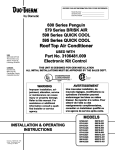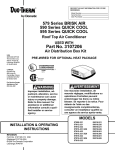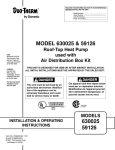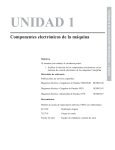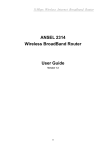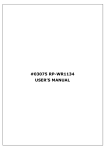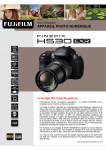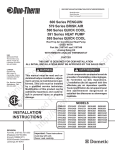Download Dometic 59136.521 Specifications
Transcript
® RECORD THIS UNIT INFORMATION FOR FUTURE REFERENCE: Model Number Serial Number Date Purchased 630 Series PENGUIN 600 Series PENGUIN 579 Series BRISK AIR 595 Series QUICK COOL 591 Series HEAT PUMP USED WITH Roof Top Air Conditioners & Heat Pumps USA SERVICE OFFICE The Dometic Corp. 509 So. Poplar St. LaGrange, IN 46761 (219) 463-4858 CANADA Dometic Dist. 866 Langs Dr. Cambridge, Ontario CANADA N3H 2N7 (519) 653-4390 Part No. 3106481.009 Electronic Control Kit THIS UNIT IS DESIGNED FOR OEM INSTALLATION ALL INITIAL INSTALLATIONS MUST BE APPROVED BY THE DOMETIC CORP. ® ® CERTIFIED LR23565 637G For Service Center Assistance Call: 800-544-4881 Improper installation, adjustment, alteration, service or maintenance can cause injury or property damage. Refer to this manual. For assistance or additional information consult a qualified installer or service agency. Une mauvaise installation, de mauvais réglages, modifications ou opérations d’entretien peuvent endommager les biens ou même blesser. Se reporter à la notice. Pour obtenir de l’aide ou des reseignements complémentaires, consulter un installateur qualifié ou une agence de service après-vente. MODELS 57908 57912 57915 59136 INSTALLATION INSTRUCTIONS Form No. 3106593.027 9/95 (Replaces 3106593.001,.019) ©1996 The Dometic Corp. LaGrange, IN 46761 1 59516 600312 600315 630035 SPECIFICATIONS MODEL NO. 57908 .521 Nominal Capacity (BTU/HR) * 7,100 59516 .501 .506 .601 .606 57915 57915 57915 .522 .621 .622 .521 .421 .622 .426 .422 .526 .626 57912 .621 11,000 13,500 Electrical Rating 13,500 13,500 59136.521 600312 .321 600312 .421 600315 .321 600315 .421 630035 .421 15,000 15,000 11,000 11,000 13,500 13,500 13,500 12.9 12.9 9.5 10.7 12.4 11.5 11.5 115 VAC, 60 Hz., 1 ph. Compressor Rated Load Amps 6.6 8.5 11.5 12.1 11.0 Fan Motor Rated Load Amps 2.5 2.5 2.5 2.5 2.5 2.5 2.5 3.1 3.1 3.1 3.1 3.1 Compressor Locked Rotor Amps 34.0 48.3 50.0 59.0 54.4 71.0 71.0 53.0 50.0 60.0 50.0 50.0 Fan Motor Locked Rotor Amps 5.8 5.8 5.8 5.8 5.8 6.0 6.0 8.8 8.8 8.8 8.8 8.8 Heater Amps/Watts @ 120VAC NOT AVAILABLE ON THESE MODELS SCFM-High Speed Max./Min. 325 / 250 Total Static - Min/Max. 17.0 16.0 16.5 16.0 16.5 31.0 34.5 0.12/0.65" W.C. 16.5 16.0 15.5 101 96 .4/1.1 17.0 19.5 102 102 12 AWG Copper Up to 24 ft. AC Circuit Protection 20 Amp Time Delay Fuse or 20 Amp HACR Circuit Breaker DC Circuit Protection Installation must comply with all National, State, Providence, and/or local Electrical Codes Installed Weight (Pounds) Size *** 335/250 0.40/1.10 18.5 13.5 14.5 16.0 Minimum Wire Size ** NOT AVAILABLE ON THESE MODELS 350/250 0.55 / 0.90" W.C. Refrigerant R22 Charge ( Oz.) Minimum Generator 2.7/1530 75 94 1 Unit 2 Units 100 94 94 102 105 95 2.5 KW 3.5 KW 2.5 KW 3.5 KW 4.0 KW 5.0 KW 4.0 KW 5.0 KW * Maximum unit performance achieved at full rated voltage. ** For distances over 24 ft. consult the National Electrical Code. *** The Dometic Corporation gives GENERAL guidelines for generator requirements. These guidelines come from experiences people have had in actual applications. When sizing the generator, the total power usage of your recreational vehicle must be considered. Also keep in mind generators lose power at high altitudes and from lack of maintenance. 1. GENERAL INFORMATION A. This air conditioner is designed for: B. Condensation NOTE 1. Installation on a recreational vehicle at the time the vehicle is manufactured. The manufacturer of this air conditioner will not be responsible for damage caused by condensed moisture on ceilings or other surfaces. Air contains moisture and this moisture tends to condense on cold surfaces. When air enters the RV, condensed moisture may appear on the ceiling, windows, metal parts, etc. The air conditioner removes this moisture from the air during normal operation. Keeping doors and windows closed when this air conditioner is in operation will minimize condensed moisture on cold surfaces. 2. Mounting on the roof of a recreational vehicle. 3. Connection to an air distribution system located in the ceiling/roof cavity of the recreational vehicle. 4. Roof construction with rafters/joists on minimum of 16 inch centers. 5. Minimum of 2.00 inches and maximum of 5.50 inches distance between roof to ceiling of recreational vehicle. Alternate installation methods will allow for roofs more than 5.50 inches thick. 2 INSTALLATION INSTRUCTIONS 1. PRECAUTIONS WARNING It is preferred that the air conditioner be installed in a relatively flat and level roof section measured with the RV parked on a level surface; however, a. Up to an 8o slant to either side, or front-to-back, is acceptable on 600 and 630 Series units b. Up to a 15° slant to either side or front-to-back is acceptable on 591 Series Heat Pumps. IMPROPER INSTALLATION MAY DAMAGE EQUIPMENT, COULD ENDANGER LIFE, CAUSE SERIOUS INJURY AND/OR PROPERTY DAMAGE. A. Read Installation and operating instructions carefully before attempting to start your air conditioner installation. B. The Dometic Corporation will not be liable for any damages or injury incurred due to failure in following these instructions. C. Installation must comply with the National Electrical Code and any State or Local Codes or regulations. D. DO NOT add any devices or accessories to this air conditioner except those specifically authorized by Dometic. E. This equipment must be serviced by qualified personnel and some states require these people to be li- C. AFTER LOCATION HAS BEEN SELECTED: 1. Check for obstructions in the area where air conditioner will be installed. 2. The roof must be designed to support 130 pounds when the RV is in motion. Normally 200 pound static load design will meet this requirement. NOTE IT IS THE RESPONSIBILITY OF THE INSTALLER OF THIS AIR CONDITIONER SYSTEM TO INSURE THE STRUCTURAL INTEGRITY OF THE RV ROOF. censed. 3. AIR DISTRIBUTION SYSTEM SIZING & DESIGN 2. CHOOSING LOCATION FOR THE AIR CONDITIONER The Installer of this Air Conditioner System must design the air distribution system for his particular application. Several requirements for this system MUST be met for the Air Conditioner to operate properly. These requirements are as follows: This air conditioner is specifically designed for installation on the roof of a recreational vehicle (RV). A. For One Unit Installation: The air conditioner should be mounted slightly forward of center (front to back) and centered from side to side. A. Roof cavity thickness must be between 2.00" to 5.50". This distance is measured between roof and ceiling surface. B. For Two Unit Installations: Install one air conditioner 1/3 and one air conditioner 2/3’s from front of RV and centered from side to side. FIG. 1 AIR CONDITIONER DIMENSIONS (On Top of Vehicle) 600 & 630 SERIES 579, 591 & 595 SERIES AIR CONDIT IONER DIMENSIONS (On T op of V ehicle) 4" 4" KEEP T HIS A REA F REE OF OBST RUCTIONS 7-1/4" 7-3/4" 4-1/4" 15" 5-3/8" REAR OF UNIT 14" x 14" OPENING 21-1/2" 14" x 14" OPENING REAR OF UNIT Center L ine of Unit 7-1/4" 7-3/4" KEEP T HESE A REAS FREE OF OBST RUCTIONS 18" 3 12" B. The total Cross-Sectional Discharge Area of outlet ducts from the Plenum Area under the Air Conditioner must be as follows: 1. 579 & 600 Series; 17.5 sq. in. 2. 591, 595 & 630 Series; 21.0 sq. in. J. Total System Pressure must be between the following: 1. 0.55 to 0.90 in.W.C. for 579 Series 2. 0.40 to 1.10 in.W.C. for 591, 595 & 630 Series 3. 0.12 to 0.65 in W.C. for 600 Series This is determined with the Air Conditioner Blower operation on High Speed and Return Air Filter and Grille in place. C. Duct Sizing Requirements as follows: Min. Max. 1. Duct Depth (591, 595 & 630 Series) 1-1/2" 2-1/4" (579 & 600 Series) 1-1/4" 2-1/4" 2. Duct Width 7.00" — — — 3. Total Duct Length 12 ft. 36 ft. 4. Duct Length (Short Run) 1/3 Total Length D. Register Requirements as follows: Min. 1. Distance from Duct End 5" 2. Distance from End of Elbow 15" 3. Distance between Registers 24" 4. Total Number Required/AC 4 5. Number required per Run/AC 2 6. Free Area per Register 14 sq. in. 4. AIR DISTRIBUTION SYSTEM INSTALLATION The Dometic Corporation recommends the basic configuration shown below for installing this Air Conditioner System. We have found by testing, that this configuration works best in most applications of this Air Conditioner System. Max. 8" — — 8 — — It is the responsibility of the Installer of this System to review each RV floor plan and determine the following: A. Duct size B. Duct layout C. Register size D. Register locations E. Thermostat location. These items must be determined in conjunction with the Air Distribution System Sizing and Design Requirements listed in Section 3 of this manual. E. The Duct material must meet or exceed any agency or RVIA Standard that may be in existence at the time the RV is produced. ALTERNATE CONFIGURATIONS AND METHODS MAY BE USED WHICH STILL ALLOW THE AIR CONDITIONER TO OPERATE PROPERLY. HOWEVER, THESE ALTERNATE CONFIGURATIONS AND METHODS MUST BE APPROVED BY THE DOMETIC CORPORATION IN WRITING. IT IS THE RESPONSIBILITY OF THE INSTALLER OF THIS SYSTEM TO INSURE THE DUCT-WORK WILL NOT COLLAPSE OR BEND DURING OR AFTER THE INSTALLATION. F. All Discharge Air Ducts must be properly insulated to prevent condensation from forming on their surfaces or adjacent surfaces during operation of the Air Conditioner or heat pump. This insulation must be R-7 minimum. The following instructions are based upon the use of Dometic Return Air Kit No. 3105007 or 3105935. The electronic control kit has mounting bolts supplied for use with this Kit. A. Before preparing the ceiling opening, the type of system options must be decided upon. If a remote sensor is to be used, provision must be made for it. If the load shed option (Energy Management System feature) is to be used, wires must be run from the load shed control to the Dometic A/C. If a furnace is to be connected, wires must be run from the furnace to the Dometic A/C. Read all of the following instructions before beginning the installation. G. Ducts and their joints must be sealed to prevent condensation from forming on adjacent surfaces during operation of the Air Conditioner. NOTE THE DOMETIC CORPORATION WILL NOT BE HELD LIABLE FOR ROOF STRUCTURAL OR CEILING DAMAGE DUE TO IMPROPERLY INSULATED OR SEALED DUCT-WORK. H. Return Air Opening must have 40 sq. in. minimum free area including the filter. B. ROOF AND CEILING OPENING PREPARATION 1) A 14" x 14" opening must be cut through the roof and ceiling of the RV. This opening must be located between the roof and reinforcing members. I. Return Air to the Air Conditioner must be filtered to prevent dirt accumulation on Air Conditioner Cooling surface. 4 7) Route a dedicated 12 VDC supply line (18-22 AWG) from the RV's Converter or Battery to the roof opening. a. This supply line must be located in the front portion of the 14" opening. b. Make sure that at least 15" of supply wire extends into the roof opening. c. In a multiple zone installation, this wiring is required in only one of the 14" openings. THERE MAY BE ELECTRICAL WIRING BETWEEN THE ROOF AND THE CEILING. DISCONNECT ALL POWER SUPPLIES AND THE POSITIVE (+ ) TERMINAL FROM THE SUPPLY BATTERY. FAILURE TO FOLLOW THIS INSTRUCTION MAY CREATE A SHOCK HAZARD. 2) Mark a 14" x 14" square on the roof and carefully cut the opening. 3) Using the roof opening as a guide, cut the matching hole in the ceiling. 4) The opening created must be framed to provide adequate support and prevent air from being drawn from the roof cavity. Lumber 3/4" or more in thickness must be used. Remember to provide an entrance hole for power supplies, furnace wiring, 4-conductor telephone cable, remote sensing and load shed options as desired. 5) The 14" opening is part of the return air system of the Air Conditioner and must be finished in accordance with NFPA Standard 501C Section 2.7. 6) Route a copper 12 AWG, with ground, 115 VAC supply line from the fuse or circuit breaker box to the roof opening. a. This supply line must be located in the front portion of the 14" opening. b. The power supply MUST be on a separate 20 amp Time Delay Fuse or HACR Circuit Breaker. c. Make sure at least 15" of supply wire extends into the roof opening. This ensures easy connection at the Junction Box. d. Wiring must comply with all National, State and Local Wiring Codes. e. Use a steel sleeve and a grommet or equivalent methods to protect the wire where it passes into the opening. 8) If a Remote Temperature Sensor is to be used , the connector end must be routed to the roof opening of the system which it will control. Make sure that at least 15" of the sensor cable extends into the roof opening. 9) If a furnace is to be controlled by the system, the two furnace thermostat leads must be routed to the roof opening of the air conditioner that will control it. Make sure at least 15" of the furnace thermostat wires extend into the roof opening. 10) If an Energy Management System- EMS (load shed) is to be used with the control, two wires must be routed to the roof opening of the zone to be managed. The signal required for this function is a normally open relay contact. When the EMS calls for the compressor to shut off, the relay contacts should close. Make sure that at least 15" of the EMS wires extend into the roof opening. FIG. 2 TOTAL OUTLET AIR AREA MINIMUM: 17.5 sq. in. - 579 & 600 Series 21.0 sq. in. - 591, 595 & 630 & 595 Series SHORT RUN DUCT MIN. 1/3 TOTAL DUCT LENGTH AIR CONDITIONER REGISTERS DUCTS DEPTH (591,595, 630 Series) (579, 600 Series) WIDTH TOTAL LENGTH MIN. 1-1/2" 1-1/4" 7" 12' 4 MIN. — 8 MAX. (Per A/C) 14 SQ. IN. FREE AREA PER REGISTER MAX. 2-1/4" 2-1/4" —— 36' 14 INCH ROOF OPENING ROOF RAFTERS 5 VEHICLE FRONT 11) Route a 4-conductor telephone cable from the Comfort Control Center™ mounting position into the 14" roof opening. Make sure that at least 15" of the wire extends into the roof opening and 6" extend from the wall at the mounting position of the Comfort Control Center™. Terminate the start of the Duct at the back edge of the 14" opening previously cut. FIG. 4 12) In the event that other A/C's are to be installed (additional zones) an additional 4-conductor telephone cable must be routed to the other A/C's. Make sure that at least 15" of the wire extends into each of the roof openings. See FIG. 3. C. AIR DISTRIBUTION DUCT INSTALLATION Install the Air Distribution Ducts in the RV Roof Cavity. The Distribution System must meet: 1. RV’s requirements 2. System requirements listed in Section 3 of this Manual. FIG. 3 6 C. COMFORT CONTROL CENTER™ INSTALLATION 5. DOMETIC COMFORT CONTROL CENTER ™ & CABLE INSTALLATION 1) Carefully remove the base plate from the Comfort Control Center™. This may be accomplished by inserting a screwdriver under the tab on the bottom edge of the front cover and gently prying. (See FIG. 6). A. LOCATION 1) If the system is to be used WITHOUT a Remote Temperature Sensor, the proper location of the Comfort Control Center™ is very important to ensure that it will provide a comfortable RV temperature. Observe the following rules when selecting a location. a. Locate the Comfort Control Center™ 54" above the floor. b. Install the Comfort Control Center™ on a partition, not on an outside wall. c. NEVER expose it to direct heat from lamps, sun or other heat producing items. d. Avoid locations close to doors that lead outside, windows or adjoining outside walls. e. Avoid locations close to supply registers and the air from them. 2) If the system is to be used WITH a Remote Temperature Sensor in ALL zones, the comfort Control Center may be mounted anywhere that is convenient in the coach. Try to avoid hard to reach and hard to see areas. a. Refer to the instructions provided with the Remote Temperature Sensor for details of installation. 3) A 3/8" diameter hole will be needed to route the telephone cable through the wall. FIG. 6 2) Insert the telephone cable through the hole in the base plate and mount the plate to the wall with the two screws provided. 3) Install the control cable RJ-11 connector into the back of the Comfort Control Center™ and gently press onto the base plate. B. CONTROL CABLE INSTALLATION A 4-conductor telephone cable must be routed from the roof opening to the Comfort Control Center™. 1) Choose the shortest, most direct route from the 14" opening to the Comfort Control Center™ location selected. Leave 6" of cable extending through the wall. 2) The cable that should be used is a flat, 4-conductor telephone cable. 3) The cable must be terminated with a telephone RJ11 connector. Refer to the crimp tool manufacturer for crimping instructions. Ensure that the cable is installed into the connector correctly before crimping. (See FIG. 5). 6. PLACING THE AIR CONDITIONER ON THE ROOF A. Remove the Air Conditioner from the carton and discard. BE KIND RECYCLE ALL CARDBOARD FIG. 7 FIG. 5 B. Place the Air Conditioner on the roof. USE CARE IN LIFTING. THIS UNIT WEIGHS APPROXIMATELY ONE HUNDRED (100) POUNDS. 7 Control Kit package. 5) Take the ceiling template and hold up to the 14" opening. 6) Start each mounting bolt through the ceiling template and up into the unit base pan by hand. 7) Evenly tighten mounting bolts to a torque of 40 to 50 Inch Pounds. This will compress the roof gasket to approximately 1/2". The bolts are self locking so over tightening is not necessary. 8) Install wood screw in each end of ceiling template. This insures a tight fit of return air cover to ceiling. C. Lift and place the unit over the prepared opening using the gasket on unit as a guide. The blunt end goes toward the rear of the RV. FIG. 8 FRONT FIG. 10 DO NOT SLIDE THE UNIT. THIS MAY DAMAGE THE NEOPRENE GASKET ATTACHED TO THE BOTTOM AND CREATE A LEAKY INSTALLATION. D. Place the Electronic Control Kit and the Return Air Cover Kit inside the RV. These cartons contain mounting hardware for the air conditioner and will be used inside the RV. This completes the outside work. Minor adjustments can be done from the inside of the RV if required. 7. INSTALLATION OF AIR CONDITIONER FIG. 9 Return A ir Grille B. INSTALLATION OF DIVIDER PLATE 1) Measure the ceiling to roof thickness: a. If distance is 2.00" - 3.75", remove perforated tab from Divider Plate. b. If distance is 3.75" - 5.50", remove no tabs. 2) Remove the backing paper from double sided tape located on Ceiling Template. 3) Place Divider Plate up to bottom of Air Conditioner base pan firmly. The foam tape on the divider plate must seal to bottom of base pan. Return A ir Cover Ceiling Template Divider Plate FIG. 11 A. INSTALLATION OF CEILING TEMPLATE 1) Check gasket alignment of the Air Conditioner over roof opening and adjust if necessary. Unit may be moved from below by slightly lifting and sliding. 2) Reach up into the return air opening of the Air Conditioner and pull the unit electrical cord down for later connection. 3) Remove Return Air Cover and Ceiling Template from the 3105007 or 3105935, return air cover kit carton. 4) Locate 1/4" unit mounting bolts in the Electronic 8 NOTE C. INSTALLATION OF ELECTRONIC CONTROL KIT The adhesive on double sided tape is extremely sticky. Divider Plate must be properly positioned before pressing in place. NOTE: If your installation includes the optional Electric Heat Kit, install it at this time. This optional Heat Kit is approved for use on 595 Series Air Conditioners only. Follow the instructions with the heat package for its installation procedure. FIG. 12 1) Terminate the 4-conductor telephone cable(s) protruding into the 14" roof opening. The cable(s) must be terminated with a telephone RJ-11 connector. Refer to the crimp tool manufacturer for crimping instructions. Ensure that the cable is installed into the connector correctly before crimping. (See FIG. 5). 2) Remove the screw holding the junction box cover to the Electronic Control Kit. Remove the cover. 579, 591 AND 595 SERIES 1) Snap the Freeze Control Sensor onto the return bend of the evaporator coil. (See FIG. 13 & 14). a. Locate "D" shaped notch in the flange of the evaporator coil. b. Place the horseshoe end of the Freeze Control Sensor through this notch and snap it onto the return bend. When positioned correctly, the control wires will be 90 degrees to the direction of the coil fin surface. 4) With slight pressure, push the divider plate against the exposed double sided tape on ceiling template. 5) Locate 1/8" x 7" x 18" self-adhesive insulation supplied with the Return Air Kit. 6) Remove the backing paper from the insulation and carefully stick onto the ceiling template divider panel. NOTE 600 AND 630 SERIES The adhesive on insulation is extremely sticky. Be sure part is located where desired before pressing into place. We recommend pulling off part of backing paper, locating part and then remove backing paper as insulation is pressed into place. 1) Snap the Freeze Control Sensor onto the return bend of the evaporator coil. Located at right side of FIG. 14 579, 591 & 595 FREEZE CONTROL a. Excess width is intended to seal the divider plate to the sides of the 14" opening, This is to prevent cold discharge air from circulating into the Air Conditioner return air opening. b. If the insulation is too high, stick the excess height of insulation to the Air Conditioner base pan. Note: Do not cover up unit rating plate. FIG. 13 9 2) 3) 4) 5) evaporator. (See FIG. 15). a. Locate vertical return bend at lower right of evaporator coil. b. Place the horseshoe end of the Freeze Control onto this coil return bend and snap into place. When positioned correctly, control wires will be 90 degrees to the direction of the coil fin surface. Plug the unit electrical cord into the mating connector on the Electronic Control Kit. These connectors are polarized and will easily snap together. DO NOT FORCE. Plug the telephone cable(s) into the telephone jack(s) visible on the side of the Electronic Control Kit. (It does not matter which one.) Locate the Electronic Control Kit on the ceiling template. Drive two #10 x 3/8 blunt point phillips head screws (provided in the parts package) through the ceiling template into the holes in the Electronic Control Kit to hold it in place. trol Kit. (In multiple zone installations, this needs to be done at only one zone.) Connect +12 VDC to the red wire; –12 VDC to the black wire. 3) Connect the previously run furnace thermostat wires (if applicable) to the blue wires protruding from the Electronic Control Kit. The polarity of these connections does not matter. 4) Connect the previously run Energy Management System wires for load shed (if applicable) to the yellow wires protruding from the Electronic Control Kit. The polarity of these connections does not matter. 5) If the unit is a Heat Pump model, route the Ambient Air Sensor Cable, already installed in the base model, through the grommet in the Electronic Control Kit and attach it to the connector that matches its color. (See FIG.16). E. ELECTRONIC CONTROL KIT FIG. 16 D. CONNECTION OF LOW VOLTAGE FIG. 15 600 & 630 FREEZE CONTROL D k o m dkd fm f CONFIGURATION 1) Adjust the dip switches visible in the Electronic Control Kit according to the options that are installed. (See FIG. 17). Placing the switch in the ON position selects that option. NOTE: Dip switches are shipped from the factory in the "OFF" position. 2) Selection of ZONE 2 identifies this unit as Zone 2; likewise, Zone 3 and 4. 3) STAGE is not used on these units. Leave in the "OFF" position. 4) HEAT STRIP is placed to "ON" if an Electric Heat Strip is installed. F. CONNECTION OF 115 VOLT POWER WIRES FIG. 17 Ensure that the 12 VDC power is shut off. 1) Route the Remote Temperature Sensor cable, if applicable, through the grommet in the Electronic Control Kit and attach it to the connector that matches its color. 2) Connect the previously run 12 VDC to the red and black wires protruding from the Electronic Con10 functioning, perform the following configuration procedure: a. Simultaneously depress the UP and DN pushbuttons on the Comfort Control Center™ for one second. This completes the system configuration. SUPPLY 1) Route the previously run power supply line through the Romex Connector and into the Electronic Control Kit Junction Box. 2) Connect the white to white; black to black; and green to green or bare copper wire using appropriate sized twist wire connectors. Tape the twist wire connectors to the supply wiring to assure they do not vibrate off. 3) Tighten screws on strain relief connector being careful not to pinch and cut into the insulation on power supply leads. 4) Push excess wires into junction box. Replace the junction box cover onto the Electronic Control Kit. H. 1. 2. 3. INSTALLATION OF RETURN AIR COVER Remove Return Air Grille from the Return Air Cover. Place the Return Air Cover up to Ceiling Template. Install Cover to Template with #8 x 3/8" blunt point phillips head screws provided (6 required). 4. Reinstall Return Air Grille into Return Air Cover. 5. Install two (2) hole plugs into screw holes in back of return air grille. Align tabs with mating notches and snap filter into place. (See FIG. 18) G. SYSTEM CHECKOUT & CONFIGURATION Now that the system is installed, it is necessary to check all operations and then configure the electronics. FIG. 18 Refer to the Operating manual for a description of the air conditioner operation. 1) SYSTEM CHECKOUT: Verify that all features of the installed system work. Check fan speeds, cooling mode, heat pump mode, furnace (if connected) and heat strip. If the features do not work, check all wiring and confirm that the correct options have been selected on the Electronic Control Box. See Comfort Control Center™ Operating Instructions. 2) SYSTEM CONFIGURATION: If all features are Return Air Cove Hole Plugs Return Air Grille ELECTRONIC FIELD WIRING DIAGRAM 11 UNIT FIELD WIRING DIAGRAM (A/C) HEAT PUMP FIELD WIRING 12












